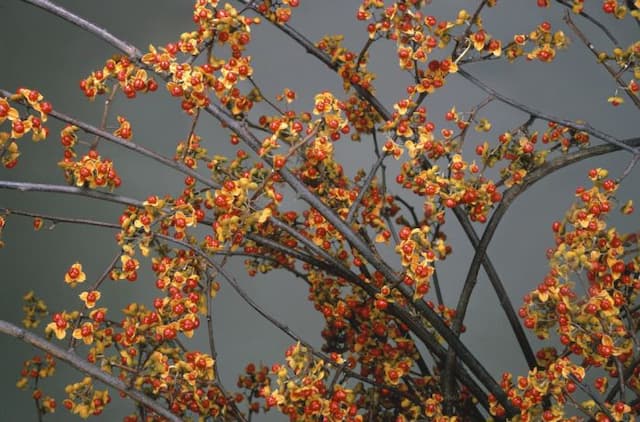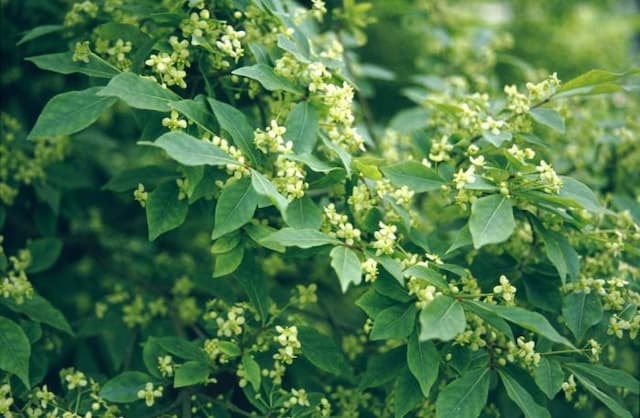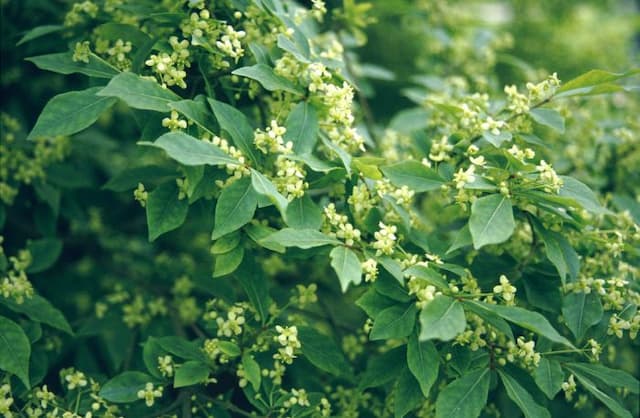European spindle Euonymus europaeus f. albus

ABOUT
The European spindle tree with the white fruit form, commonly known as the European spindle, is a stunningly ornamental plant. Its leaves are ovate to lanceolate in shape, featuring finely serrated edges and a rich green color that often transforms into a stunning display of reds and purples in the fall. This shifting palette brings a dynamic visual interest to landscapes across the seasons. Clusters of small, inconspicuous flowers bloom on the European spindle in spring, typically showing a yellow-green hue that blends subtly with the foliage. As the blossoms give way to fruit, the plant reveals one of its most distinctive features: the white fruits that contrast starkly against the leafy backdrop and autumn hues, drawing eyes with their uniqueness. These fruits are paired with showy, bright pink capsules that split open in the fall to reveal the encased seeds, which are coated in a striking, fleshy orange aril. The juxtaposition of the white fruit, orange seeds, and pink capsules is particularly eye-catching and is a key ornamental attribute of the plant. The European spindle boasts stems and branches that have a noticeable, smooth gray bark, providing yet another layer of textural and visual interest throughout the year. During the winter months, when the leaves have dropped, this bark continues to lend character to the barren landscape. Throughout its growing season, the European spindle tree with the white fruit form maintains a bushy, robust appearance, with a dense branching structure that can create a thick screen or hedge when planted with others of its kind. Its presence in a garden setting is often noted for both its colorful, changing foliage and its ornamental fruits, which persist and captivate long after many other plants have receded into winter dormancy.
About this plant
 Names
NamesFamily
Celastraceae
Synonyms
European Spindle, Common Spindle, Spindle Tree, Spindle Bush
Common names
Euonymus europaeus var. albus, Euonymus europaeus forma albus.
 Toxicity
ToxicityTo humans
The common name for Euonymus europaeus f. albus is Spindle. The Spindle plant is considered toxic to humans when ingested and can cause a range of symptoms. Ingesting parts of this plant, especially the fruits and seeds, may lead to abdominal pain, diarrhea, nausea, vomiting, and weakness. In some cases, consuming large quantities could potentially result in more severe effects, such as changes in heart rhythm, convulsions, and possibly coma. The severity of symptoms usually depends on the amount of plant material ingested. Therefore, caution should be taken to ensure children, in particular, do not ingest parts of the plant.
To pets
The Spindle plant is also toxic to pets. Just as with humans, ingestion of any part of the Spindle plant, particularly the seeds and fruits, can cause symptoms of poisoning in domestic animals such as dogs and cats. These symptoms may include vomiting, diarrhea, abdominal pain, weakness, and in severe cases, seizures or heart complications. If a pet ingests Spindle, it is important to seek veterinary care immediately to manage and mitigate the effects of the toxicity.
 Characteristics
CharacteristicsLife cycle
Perennials
Foliage type
Deciduous
Color of leaves
Green
Flower color
White
Height
6 feet (1.8 meters)
Spread
6 feet (1.8 meters)
Plant type
Shrub
Hardiness zones
5
Native area
Europe
Benefits
 General Benefits
General Benefits- Ornamental Value: Euonymus europaeus, commonly known as European spindle, offers aesthetic appeal to gardens with its distinctive foliage and bright-colored fruits.
- Wildlife Habitat: The plant provides shelter and nesting sites for various bird species.
- Food Source for Wildlife: The fruits serve as a food source for birds and small mammals during the autumn and winter months.
- Low Maintenance: European spindle is known for being hardy and requiring minimal care, making it suitable for low-maintenance landscaping.
- Drought Resistance: Once established, it can tolerate periods of drought, reducing the need for watering.
- Erosion Control: The plant's root system helps stabilize soil and prevent erosion, particularly on slopes or in areas with loose soil.
 Medical Properties
Medical Properties- This plant is not used for medical purposes.
 Air-purifying Qualities
Air-purifying QualitiesThis plant is not specifically known for air purifying qualities.
 Other Uses
Other Uses- Euonymus europaeus, commonly known as Spindle, can be used for making spindles for spinning wheels, as its name suggests, because the hardwood is suitable for fine, turned items.
- The wood of the Spindle tree is dense and can be used for making musical instruments, providing a good material for small parts such as pegs.
- The Spindle tree's colorful fruits and attractive autumn foliage make it a valuable ornamental plant for gardens and parks.
- The seeds are sometimes used for making jewelry or decorative items due to their unique and vibrant appearance.
- Spindle wood can be used for creating charcoal for drawing, offering a medium hardness that artists may prefer.
- The natural dyes extracted from the fruits and bark can be used in textile coloring, producing shades of yellow and grey.
- Woodturners can use Spindle wood for crafting fine, detailed wooden objects such as chess pieces and intricate carvings.
- In some traditions, the branches are used for making divining rods, which are claimed to find water or minerals underground.
- The branches and stems can serve as materials for weaving small baskets or as framework for thatching due to their flexibility when young.
- The compact, dense growth habit of the Spindle can be employed in hedgerows or as a windbreak in rural landscapes.
Interesting Facts
 Feng Shui
Feng ShuiThe European spindle is not used in Feng Shui practice.
 Zodiac Sign Compitability
Zodiac Sign CompitabilityThe European spindle is not used in astrology practice.
 Plant Symbolism
Plant Symbolism- Fortune and Prosperity: The common name for Euonymus europaeus f. albus is "Spindle Tree." The Spindle Tree is often associated with fortune and prosperity due to its fruitful nature and the historical value of its wood in creating spindles used for spinning wool.
- Protection: In folklore, spindle wood was thought to have protective properties and was used to make charms to ward off evil.
- Boundary Setting: Because spindle trees were commonly used as hedging plants, they symbolize boundary setting and defining one's own space.
 Water
WaterThe European Spindle (Euonymus europaeus) prefers a consistent watering schedule, usually requiring water when the top inch of soil feels dry. In general, this might mean watering every week, but it can vary depending on climate conditions and season. During hotter months or in drier climates, you might need to increase watering frequency. Provide the plant with about 1 to 1.5 gallons of water per session, ensuring the soil is moist but not waterlogged. Reduce watering in the winter when the plant's growth slows down.
 Light
LightThe European Spindle thrives best in full sun to partial shade conditions. It should be placed in a location where it can receive at least 4 to 6 hours of sunlight every day. An ideal spot would be one that gets morning sun and is shaded from the intense afternoon sun, to prevent leaf scorch.
 Temperature
TemperatureThe European Spindle is hardy and can withstand a range of temperatures, from about -20°F to 90°F. However, the ideal temperature range for this plant is between 60°F and 70°F. Extreme temperatures outside this range might impede its growth, but the plant can survive short periods of harsh weather if properly established.
 Pruning
PruningPruning the European Spindle is important to maintain its shape and to remove any dead or diseased branches. The best time for pruning is during the late winter or early spring before new growth begins. Prune as needed, usually once a year, to keep the plant healthy and to encourage bushier growth.
 Cleaning
CleaningAs needed
 Soil
SoilEuropean Spindle prefers well-draining soil rich in organic matter with a pH between 6.0 and 7.5. A good mix would be one part garden soil, one part peat, and one part perlite or coarse sand to improve drainage.
 Repotting
RepottingEuropean Spindle does not require frequent repotting and can be done every 2-3 years or when the plant outgrows its pot.
 Humidity & Misting
Humidity & MistingEuropean Spindle thrives in moderate humidity levels and can tolerate a range typical of outdoor environments; no specific humidity level is critical.
 Suitable locations
Suitable locationsIndoor
Place European Spindle in bright indirect light, away from drafts.
Outdoor
Plant in well-draining soil, sun or partial shade.
Hardiness zone
4-7 USDA
 Life cycle
Life cycleThe spindle tree (Euonymus europaeus f. albus) begins its life as a seed, typically dispersed by birds who feed on its attractive fruit in the fall. After a period of dormancy through winter, these seeds germinate in spring if the conditions are favorable, requiring stratification to break dormancy. The young spindle tree then enters the seedling stage, slowly developing its root system and foliage. As it matures into a sapling over the following years, it establishes a more robust root system and begins to form a woody stem. Once fully grown, it reaches the flowering stage, where small, inconspicuous flowers bloom in late spring to early summer, which are then pollinated primarily by insects. The plant finally produces its characteristic white fruit in the fall, completing its life cycle, and offering a new generation of seeds for dispersal.
 Propogation
PropogationPropogation time
Spring to summer
The European spindle tree 'Euonymus europaeus f. albus', more commonly known as the White Spindle, is typically propagated using seed stratification as its most popular method. This process involves collecting seeds in the fall once they've matured and are dried. These seeds then undergo a period of cold treatment to break their dormancy, mimicking natural winter conditions. The cold stratification usually lasts for about 10-12 weeks at temperatures ranging from 34 to 41 degrees Fahrenheit (1 to 5 degrees Celsius). After this, seeds are sown in well-drained soil in a sheltered outdoor location or under controlled conditions, and with proper care, they will germinate in the spring as temperatures rise. The seedlings are then nurtured until they are strong enough to be planted in their permanent location.




![Spindle [Blondy]](/_next/image?url=https%3A%2F%2Fplants-admin.emdemapps.com%2Fimages%2Fplants%2F%2Fimages%2F604b642f54add.png&w=640&q=75)


